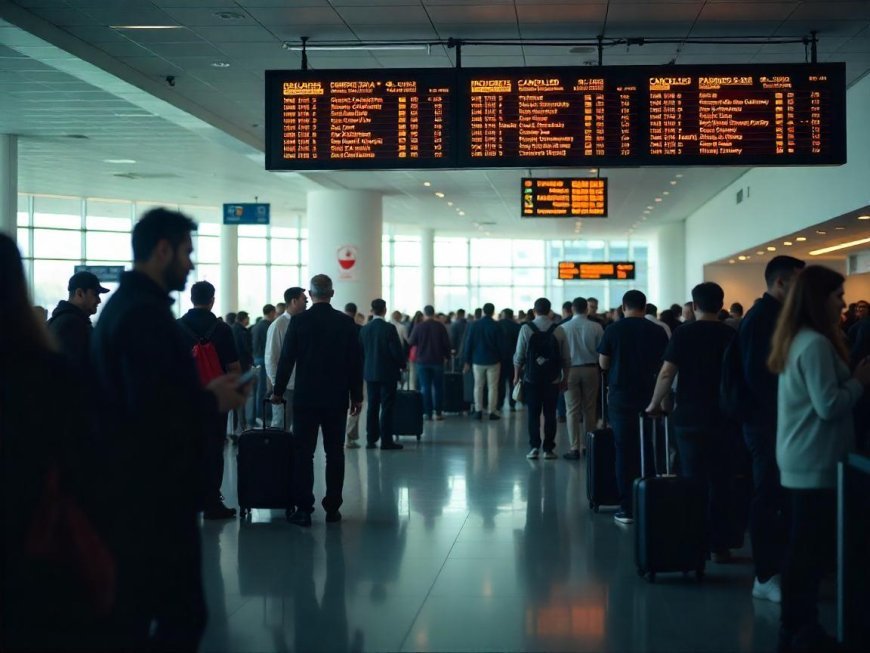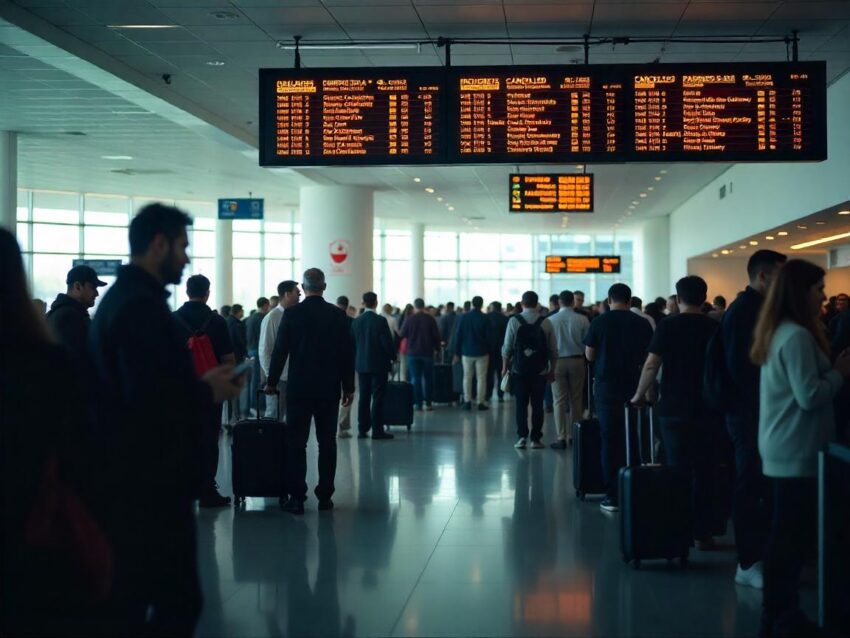Over Twenty Six Thousand Flights Delayed and Nearly Seven Hundred Cancelled in One Day, Now, US Hit Hard with Four Thousand and Four Hundred and Eighty-Seven Delays, New Update You Need To Know


A staggering wave of global flight disruptions has sent shockwaves through the travel industry, with over twenty-six thousand delays and nearly seven hundred cancellations recorded in just a single day. The United States alone bore the brunt, reporting a crushing four thousand four hundred and eighty-seven delays—an eye-opening reflection of the growing strain on air travel systems.
For American and Canadian travelers, what should be a smooth journey is increasingly turning into an unpredictable ordeal filled with last-minute changes, long waits, and missed connections. From jam-packed East Coast hubs to ripple effects across Canadian airspace, flight chaos is becoming an everyday challenge.
Whether you’re heading out for business, a long-awaited vacation, or simply trying to get home, understanding what’s causing these disruptions—and how to prepare—has never been more essential. As airlines, airports, and travelers adapt in real-time, this latest update reveals the full scope of the crisis and what lies ahead for North American flyers.
Flight Disruptions Skyrocket Amid Operational and Weather Challenges
Flight delays and cancellations are once again testing the patience of travelers across North America. According to real-time data from FlightAware, over 26,000 global flight delays and nearly 700 cancellations occurred in a single day, with U.S.-related operations accounting for 4,487 delays and 305 cancellations. From business travelers to vacationing families, the disruption has been widespread and relentless, especially for those flying through major hubs like New York, Washington, Chicago, and Toronto.
This article breaks down the current surge in airline delays and flight cancellations, exploring the patterns across airlines, airports, and geographies. It also examines what this means for American and Canadian travelers and how to better navigate the increasingly unpredictable skies.
Airlines Under Pressure: Delays Mount Across Carriers
The data reveals a worrying pattern: major North American carriers are struggling to maintain operational stability. American Airlines reported the highest volume of delays with over 730 flights affected, while Delta Air Lines and United Airlines weren’t far behind, with 596 and 401 delays respectively.
Even smaller regional airlines like PSA Airlines, Endeavor Air, and Republic Airlines saw significant impact, each with over 100 delays. The disruption doesn’t stop with U.S.-based carriers. International airlines such as China Eastern and Spring Airlines reported delay rates of over 30%, further compounding congestion across global air routes.
This level of instability is becoming the new normal, driven by a mix of factors: pilot shortages, overbooked schedules, rising fuel costs, and lingering effects from the pandemic-era labor reductions.
Airport Gridlock: East Coast Hubs Hit Hardest
East Coast airports bore the brunt of flight disruptions. Reagan National Airport (DCA) in Washington, D.C. led the list with 29 cancellations and 93 delayed flights, representing a massive 30% disruption rate. New York’s LaGuardia and JFK airports followed closely, along with Newark Liberty, all reporting over 200 delays.
Toronto Pearson International Airport (YYZ), Canada’s largest and busiest, was also among the top 10 most affected. With nearly 100 delays in one day, it underscores a troubling trend: international and transborder flights are being impacted at both origin and destination points, amplifying the ripple effect for travelers.
West Coast travelers didn’t fare much better. Seattle-Tacoma and San Francisco International reported over 100 delays, highlighting how coast-to-coast disruptions are throttling air mobility.
Cancellations Surge: Major Routes Take a Hit
While delays are frustrating, cancellations can be devastating. American Airlines alone had to cancel 44 flights, followed by Delta with 37. These aren’t minor local routes either. Many of the cancellations involved high-traffic domestic corridors and international long-hauls.
Toronto, Miami, London Heathrow, and Chicago O’Hare were among the major destination airports impacted by flight cancellations. With cancellations affecting both inbound and outbound flights, many travelers were left stranded or forced into expensive, last-minute rebookings.
Business travelers faced missed meetings, while leisure travelers lost precious vacation days—adding financial and emotional costs to an already stretched travel season.
Why Are These Disruptions Happening? A Deep Dive Into the Causes
Multiple stressors are converging to create a perfect storm in global aviation.
- Staff Shortages: Airlines across North America and globally are still short on staff. From pilots to ground crew and air traffic controllers, labor gaps are a chronic issue post-COVID.
- Weather Extremes: Thunderstorms on the East Coast and wildfire-related air quality issues in Canada are contributing to operational shutdowns and longer ground times.
- Air Traffic Congestion: With summer in full swing, the surge in passenger volume is pushing air traffic systems to their limits. This leads to holding patterns, gate delays, and cascading disruptions.
- Aging Infrastructure: Many of the top U.S. airports suffering from delays are also grappling with outdated infrastructure that can’t accommodate modern traffic loads efficiently.
- Overambitious Scheduling: Airlines have tried to capitalize on strong summer demand by packing their schedules. But with little room for error, any disruption spreads rapidly.
How North American Travelers Are Coping
American and Canadian travelers are responding with a mix of caution, frustration, and adaptation. Many have begun to book early morning flights, which statistically have fewer delays. Others are opting for nonstop routes, avoiding connections that increase the risk of missed flights.
Travel insurance purchases are also rising, especially for international trips. According to Squaremouth, a travel insurance comparison site, claims related to delays and cancellations are up 38% year-over-year.
Frequent flyers are leaning on loyalty programs and premium credit card perks for lounge access, rebooking assistance, and compensation. Meanwhile, digital-savvy travelers are using flight tracking apps and live delay maps, like FlightAware’s MiseryMap, to stay ahead of disruptions in real-time.
Canadian Travelers Face Double Whammy
For Canadians, the impact is particularly harsh. Not only are domestic flights affected, but disruptions in the U.S. cascade into delays for transborder routes. Toronto Pearson and Montreal Trudeau are heavily intertwined with U.S. hubs, meaning a single disruption in New York or Chicago can impact dozens of flights in Canada.
Compounding the problem is Canada’s strict aviation regulations, which mandate additional safety checks and weather thresholds. These, while necessary, can slow down the rebooking and boarding processes, leading to longer wait times.
Traveler Tips for Navigating the Chaos
In a climate of persistent disruptions, here are key strategies North American travelers can adopt:
- Fly Direct: Avoid connecting flights wherever possible to reduce exposure to delay chains.
- Book Early Flights: Morning departures are statistically more reliable.
- Use Travel Apps: Apps like FlightAware, Hopper, and airline-specific tools offer real-time insights and alerts.
- Travel Light: Carry-on luggage makes rebooking easier and faster.
- Know Your Rights: Familiarize yourself with airline policies and, for Canadians, the Air Passenger Protection Regulations (APPR).
- Opt for Flexible Fares: Flexible and refundable tickets can save both money and stress.
What Airlines and Airports Are Doing in Response
Some carriers have begun scaling back aggressive scheduling to create more buffer time between flights. Delta and United have announced minor schedule cuts to improve reliability.
Airports are also making infrastructure improvements. JFK and Toronto Pearson have invested in new runway systems and gate expansions. However, many of these projects won’t bear fruit until 2026 or later.
Customer service teams are being reinforced, and new tech tools are being introduced to automate rebookings and notifications. Yet, the sentiment from most travelers remains one of skepticism. Recovery will take time.
The Bigger Picture: Long-Term Aviation Stability at Risk
What’s unfolding today may signal deeper issues in the global aviation industry. The rapid ramp-up post-COVID did not leave adequate time for workforce rebuilding or system modernization.
As climate change introduces more frequent and severe weather events, and as demand continues to surge, airlines must rethink capacity planning, sustainability investments, and traveler protections.
For North American carriers in particular, the pressure is immense. The region remains the largest air travel market globally. Failing to manage disruptions now risks losing traveler trust, especially among premium and business-class customers.
Prepare, Adapt, and Travel Smarter
Today’s flight chaos is more than a seasonal inconvenience. It’s a signal that the air travel industry must evolve to meet a new era of challenges. For American and Canadian travelers, the message is clear: plan with precision, expect the unexpected, and advocate for better policies.
As travel demand continues to climb, resilience will define the journey—not just for travelers, but for the entire aviation ecosystem.
The post Over Twenty Six Thousand Flights Delayed and Nearly Seven Hundred Cancelled in One Day, Now, US Hit Hard with Four Thousand and Four Hundred and Eighty-Seven Delays, New Update You Need To Know appeared first on Travel And Tour World.






